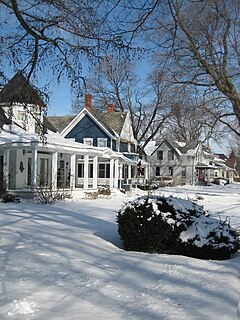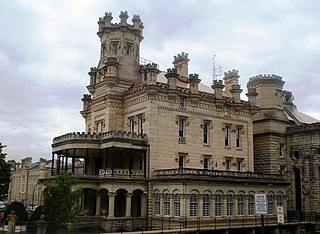
The Downtown Adrian Commercial Historic District is a historic district comprising the downtown area of Adrian, Michigan. It was designated as a Michigan Historic Site and added to the National Register of Historic Places on April 17, 1986. The district is roughly bounded on the north by Toledo Street, on the east by North Broad Street, on the south by East Church Street, and on the west by North Winter Street (M-52), West Maumee Street, and the River Raisin. Most of the district is enclosed by the US-223 Business Route, although the two are not conterminous.

The Madison County Courthouse is located in Winterset, Iowa, United States. It was listed on the National Register of Historic Places in 1981 as a part of the County Courthouses in Iowa Thematic Resource. It was included as a contributing property in the Winterset Courthouse Square Commercial Historic District in 2015. The courthouse is the third building the county has used for court functions and county administration.

The Mahaska County Courthouse located in Oskaloosa, Iowa, United States, was built in 1886. It was individually listed on the National Register of Historic Places in 1981 as a part of the County Courthouses in Iowa Thematic Resource. In 1986 it was included as a contributing property in the Oskaloosa City Square Commercial Historic District. The courthouse is the second building the county has used for court functions and county administration.

The Adair County Courthouse, located in Greenfield, Iowa, United States, was built from 1891 to 1892. It was individually listed on the National Register of Historic Places in 1981 as a part of the County Courthouses in Iowa Thematic Resource. In 2014 it was included as a contributing property in the Greenfield Public Square Historic District. The courthouse is the third structure to house county courts and administration offices.
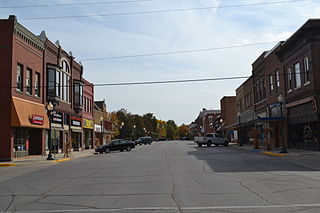
The Hampton Double Square Historic District is a historic district located in Hampton, Iowa, United States. It has been listed on the National Register of Historic Places since 2003. At the time of its nomination it contained 43 resources, which included 28 contributing buildings, two contributing sites, 10 non-contributing buildings, one non-contributing site, one non-contributing structures, and on non-contributing object. The town of Hampton was laid out by H.P. Allen, who was the county surveyor, in June 1856. The original plat was eight blocks by eight blocks in the shape of an “L”. Near the center of the “L” was the two-block, or double, square. While many county seats in Iowa have a courthouse square, the double square is a rarity. Four double squares were platted in Iowa, but only those in Hampton and Sidney survived their early period of development. Estherville's square was platted as a four-block square, but its development created a double square instead. Hampton has the only symmetrical double square plan in the state. The double square exemplifies the two primary functions of a public square, both commercial and public development.

The New Cordell Courthouse Square Historic District is a district comprising the historic commercial center of New Cordell, Washita County, Oklahoma. The district grew around the Washita County Courthouse site, which was planned in 1897 when the townsite was laid out. The commercial buildings surrounding the courthouse were mainly built from 1900 to 1925; some newer buildings, including several on First Street, are also part of the district. 80 buildings are included in the district, of which 52 are considered contributing buildings to the district's historic character. The district was added to the National Register of Historic Places on January 7, 1999.

The Marshalltown Downtown Historic District is a nationally recognized historic district located in Marshalltown, Iowa, United States. It was listed on the National Register of Historic Places in 2002. At the time of its nomination it contained 96 resources, which included 79 contributing buildings, one contributing site, and 16 non-contributing buildings. The historic district covers most of the city's central business district. All of it is within the original town of Marshalltown, which was laid out and recorded on August 15, 1853, as the village of Marshall. Confusion with a town with the same name in Henry County led this village to be renamed Marshalltown in 1862. It was incorporated the following year.
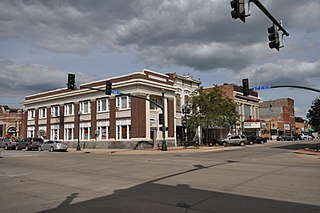
The Cherokee Commercial Historic District is a nationally recognized historic district located in Cherokee, Iowa, United States. It was listed on the National Register of Historic Places in 2005. At the time of its nomination it contained 70 resources, which included 50 contributing buildings and 20 non-contributing buildings. The historic district covers most of the city's central business district. Most of the buildings are two and three stories tall, and built of brick. There are two frame buildings from the city's earliest years. Cherokee is somewhat unusual in that it did not have a devastating fire in its history, therefore the downtown area was able to grow incrementally. Unlike many county seats, it does not have a focal point such as a centrally located courthouse square. The Cherokee County Courthouse was built on a hill to the west of the downtown area.

Harlan Courthouse Square Commercial District is a nationally recognized historic district located in Harlan, Iowa, United States. It was listed on the National Register of Historic Places in 1994. At the time of its nomination the district consisted of 54 resources, including 38 contributing buildings, one contributing site, one contributing object, 13 noncontributing buildings, and one noncontributing object. Cross-shaped in plan, the historic district covers most of the city's central business district in the original town plat. Most of the buildings are two-story, brick, commercial buildings. Commercial Italianate and Queen Anne styles are dominant. The Shelby County Courthouse (1893) is a stone Richardsonian Romanesque structure. The courthouse square block and the four surrounding half blocks and rear alleys constitute the contributing site. The Soldier's Monument on the square is the contributing object, and the POW/MIA Monument is the noncontributing object because of its more recent construction.

The Sprague, Brown, and Knowlton Store is a historic building located in Winterset, Iowa, United States. Built in 1866 to house a dry goods store, it is an early example of a vernacular limestone commercial building. The two-story structure is composed of locally quarried ashlar and rubble stone. It features chamfered quoins and jambs, and a bracketed stone cornice. Its construction has been attributed to local stonemason David Harris. The storefront has subsequently been altered. The building was individually listed on the National Register of Historic Places in 1987, and it was included as a contributing property in the Winterset Courthouse Square Commercial Historic District in 2015.

The White, Munger and Company Store is a historic building located in Winterset, Iowa, United States. Built in 1861 by Evan V. Evans who owned the property the building sits on, it is an early example of a vernacular limestone commercial building. The two-story structure is composed of locally quarried ashlar and rubble stone. It features a false front that hides the gable roof, a parapet with a bracketed stone cornice and cornice return. The storefront has subsequently been altered. White, Munger and Company operated a woolen mill east of town, and this store was associated with the mill. The building was individually listed on the National Register of Historic Places in 1987, and it was included as a contributing property in the Winterset Courthouse Square Commercial Historic District in 2015.

Greenfield Public Square Historic District is a nationally recognized historic district located in Greenfield, Iowa, United States. It was listed on the National Register of Historic Places in 2014. At the time of its nomination the district consisted of 52 resources, including 42 contributing buildings, one contributing site, six noncontributing buildings, and three noncontributing objects. The historic district covers part of the city's central business district in the center of the original town plat. There is a significant number of one- and two-story, brick, commercial buildings, as well as a few three-story structures. The Commercial Italianate style is dominant. While the vast majority of the buildings are commercial buildings, there are four government buildings in the district: the Adair County Courthouse (1892), public library (1916), city hall (1930), and the municipal light plant (1940). Besides the courthouse, the other buildings that are individually listed on the National Register include Warren Opera House Block and Hetherington Block (1896), Adair County Democrat-Adair County Free Press Building (1903), and the Hotel Greenfield (1920).

Lucas County Courthouse Square Historic District is a nationally recognized historic district located in Chariton, Iowa, United States. It was listed on the National Register of Historic Places in 2014. At the time of its nomination the district consisted of 76 resources, including 56 contributing buildings, one contributing site, one contributing structure, three contributing objects, 14 noncontributing buildings, one noncontributing structure, and one noncontributing object. The historic district covers the city's central business district in the original town plat. The buildings were either built or remodeled between 1867 and 1963, and range from one to three stories in height. They all have brick exteriors. Of the older buildings, the commercial Italianate style is dominant.

The McGregor Commercial Historic District is a nationally recognized historic district located in McGregor, Iowa, United States. It was listed on the National Register of Historic Places in 2002. At the time of its nomination the district consisted of 60 resources, including 51 contributing buildings, one contributing site, one contributing structure, and seven noncontributing buildings. Unlike most river towns in Iowa the central business district does not follow along the Mississippi River, but moves away from it. It is linear in shape, following Main Street, which runs from the southwest to the northeast in a narrow valley between two 400-foot (120 m) bluffs. The narrow valley ends at the river.
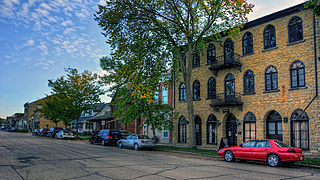
The Front Street Historic District is a nationally recognized historic district located in Guttenberg, Iowa, United States. It was listed on the National Register of Historic Places in 1984, and in 2004 its boundaries increased to include buildings that did not front onto River Park Drive. At the time of its nomination the district consisted of 75 resources, including 57 contributing buildings, one contributing site, and 17 noncontributing buildings. The boundary increase added 19 resources, including 15 contributing buildings, one contributing site, and 3 noncontributing buildings. The 4½ block segment of South River Park Drive, originally called Front Street, that makes up the district is the commercial center of Guttenberg. The buildings line the west side of the street facing a park, a contributing site, and the Mississippi River across the street. The National Fish Hatchery and Aquarium complex (1939-1940), whose buildings contribute to the historic nature of the district, is also located on the east side of the street.

Grand Avenue Historic Commercial District is a nationally recognized historic district located in Spencer, Iowa, United States. It was listed on the National Register of Historic Places in 2004. At the time of its nomination the district consisted of 57 resources, including 39 contributing buildings, and 18 noncontributing buildings. The district cover's most of the city's central business district, mainly along Grand Avenue, but on some of the intersecting streets as well. In addition to commercial buildings, the district also includes the post office, a theater, and a fraternal lodge. The commercial Romanesque Revival and Neoclassical styles are dominate. The period of significance begins in 1913 when a building boom of more "modern" construction began and ends in 1935. A fire started by fireworks destroyed nearly two full blocks, and affected 70 businesses and professional offices. The architects who designed the new buildings went for a unified approach utilizing a Spanish/Mission influence. The Iowa Legislature passed a law banning the sale of fireworks throughout the state.

The Eldora Downtown Historic District is a nationally recognized historic district located in Eldora, Iowa, United States. It was listed on the National Register of Historic Places in 2009. At the time of its nomination the district consisted of 84 resources, including 65 contributing buildings, one contributing site, three contributing objects and 15 non-contributing buildings. The district takes in the city's central business district, which also includes its governmental, educational, and religious activities. It is located in the original town plat from 1853. Development began around the public square and spread out from there. The present building stock is second generation at the earliest. The oldest extant buildings were built in the 1870s, although the greatest number of buildings were constructed in the 1890s. There were also peak years of construction in the 1910s, and the late 1930s and 1940s. The commercial buildings generally range from one to two stories, but the tallest structure is three stories in height. They are primarily composed of brick construction. Late Victorian and various revival styles from the late 19th and 20th centuries are dominate. The non-commercial buildings include four government buildings, four churches, three residences, a hospital, and a school.

The Howell Downtown Historic District is a primarily commercial historic district located along five blocks of Grand River Avenue in the center of Howell, Michigan. It was listed on the National Register of Historic Places in 1987.

The Elizabethtown Courthouse Square and Commercial District, in Elizabethtown, Kentucky, is a 10 acres (4.0 ha) historic district which was listed on the National Register of Historic Places in 1980. The listing included 38 contributing buildings.

